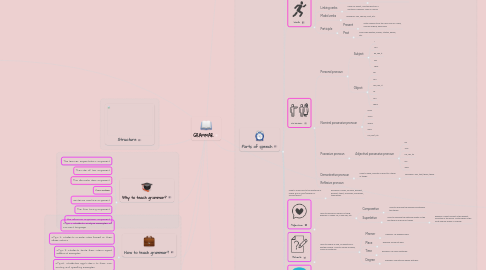
1. STEP 4: Studentes modify and add rulers as necesssary.
2. English tenses
3. Structure
4. Why to teach grammar?
4.1. The learner expectations argument
4.2. The rule of law argument
4.3. The discrete item argument
4.4. Curriculum
4.5. sentence machine argument
4.6. The fine tuning argument
4.7. the advance organiser argument
5. How to teach grammar?
5.1. STEP 1: Students analyze examples of correct language
5.2. STEP 2: Students create rules based on their observations
5.3. STEP 3: Students teste their rulers agaist additional examples.
5.4. STEP5: Studentes appl rulers to their own writing and speaking examples.
6. Example: Chris is taller than Jhon. I want to have a more powerful computer.
7. What is grammar?
7.1. Grammar describes how we combine, organise and change words and parts of words to make meaning. We use rulers for this description.
8. Parts of speech
8.1. Noun
8.1.1. Proper nouns
8.1.1.1. Refer to namer of specific people, places or organizations.
8.1.1.2. Examples: Italy, Mary, November.
8.1.2. Common nous
8.1.2.1. Examples: Dog, Book, Sub topic.
8.1.2.2. Refer to people, places in general
8.1.3. Countable nouns
8.1.3.1. Examples: Six dollars, A dog, etc.
8.1.4. Uncountable nouns
8.1.4.1. Examples: Money, electricity, etc.
8.1.5. Collective nouns
8.1.5.1. It denots a group of individuals
8.1.5.1.1. Examples: Family, boss, etc.
8.1.6. Compound nouns
8.1.6.1. Acts as a single unit and can be modified by adjectives and other nouns
8.1.6.1.1. Examples: Bus stop, mother in law, football, etc.
8.2. Numeral
8.2.1. Ordinal numbers
8.2.2. Cardinal numbers
8.2.2.1. Examples: Zero, one, two, three
8.2.3. Multiplicative adverbs
8.2.3.1. Examples: Once, twice, thrice
8.2.4. Dates
8.2.5. Fractions and demicals
8.2.5.1. Example: 1/6 is read as "one sisth"
8.3. Verb
8.3.1. Full verb
8.3.1.1. Transitive verb
8.3.1.1.1. Example: Jenna brings Mrs. Smith lunch everyday
8.3.1.2. Intransitive verb
8.3.1.2.1. Example: The bomb exploted in the city
8.3.2. Linking verbs
8.3.2.1. Have No object, Link two parts of a sentence. Example: Mary is a nurse
8.3.3. Modal verbs
8.3.3.1. Examples: Can, should, must, etc.
8.3.4. Participle
8.3.4.1. Present
8.3.4.1.1. Often refered to as the "ing" from of a verb, such as singing, swimming.
8.3.4.2. Past
8.3.4.2.1. Forms like wanted, broken, started, begun, etc.
8.4. Pronoun
8.4.1. Personal pronoun
8.4.1.1. Subject
8.4.1.1.1. I
8.4.1.1.2. You
8.4.1.1.3. he, she, it
8.4.1.1.4. We
8.4.1.1.5. They
8.4.1.2. Object
8.4.1.2.1. Me
8.4.1.2.2. You
8.4.1.2.3. Him, her, it
8.4.1.2.4. Us
8.4.1.2.5. You
8.4.1.2.6. Them
8.4.2. Nominal possessive pronoun
8.4.2.1. Mine
8.4.2.2. Yours
8.4.2.3. Theirs
8.4.2.4. Ours
8.4.2.5. His, her´s, its
8.4.3. Posessive pronoun
8.4.3.1. Adjectival possessive pronoun
8.4.3.1.1. My
8.4.3.1.2. Your
8.4.3.1.3. His, her, its
8.4.3.1.4. our
8.4.3.1.5. Their
8.4.4. Demostrative pronoun
8.4.4.1. Used to show, indicate or point to a thing or things.
8.4.4.1.1. Examples: This, that, these, those.
8.4.5. Reflexive pronoun
8.5. Used to refer back to the sentence or clause. End in "self"(singular or "selves"(plural)
8.5.1. Examples: Myself, yourself, himselft, herselft, itselft, ourselves, yourselves, themselves.
8.6. Adjective
8.6.1. Used to describe a person or thing. Example: A green car, a dark sky, etc.
8.6.1.1. Comparative
8.6.1.1.1. Used to describe the difference between two things
8.6.1.2. Superlative
8.6.1.2.1. Used to describe the extreme quality of the one thing in a group of things.
8.7. Adverb
8.7.1. Used to modify a verb, an adjective or another adverb. Used to modify a phase, clause or sentence.
8.7.1.1. Manner
8.7.1.1.1. Example: He speaks slowly.
8.7.1.2. Place
8.7.1.2.1. Example: Please sit here.
8.7.1.3. Time
8.7.1.3.1. Example: He came yesterday.
8.7.1.4. Degree
8.7.1.4.1. Example: She entirely agrees with him.
8.8. Article
8.8.1. Used to define a noun as specific or unspecific
8.8.1.1. Definite article
8.8.1.2. Indefinitive article
8.9. Preposition
8.9.1. Simple prepositions
8.9.1.1. Examples: In, on, at, over, under, etc.
8.9.2. Compound prepositions
8.9.2.1. Examples: Without, within, inside, into, behind.
8.9.3. Double prepositions
8.9.3.1. Examples: Out of, outside of, etc.
8.9.4. Participle prepositions
8.9.4.1. Examples: Concerning, considering, etc
8.9.5. Phrase prepositions
8.9.5.1. Examples: Cbecause of, with regard to, on behalf, etc.
8.9.6. Used to join two parts that aregrammatically equal. Example: And, but, ot, nor, etc.
8.10. Conuunction
8.10.1. Coordinating conjunctions
8.10.2. Subordinating conjunctions
8.10.2.1. Used to join a subordinate (depend) clause. Example: After, although, beacuse, if, etc.
8.11. Interjection
8.11.1. A short word or phrase that shows emotion. Example: My God, ouch, well, hey, er, etc.
9. CUNDINAMARCA´S UNIVERSITY
9.1. METHODS AND APROACHES TO TEACHING ENGLISH
9.1.1. KATHERIN ALEXANDRA AVILA CARDENAS
9.1.2. JENNIFER HIGUERA
